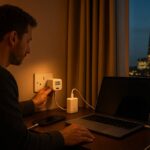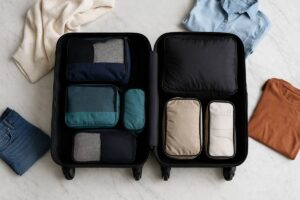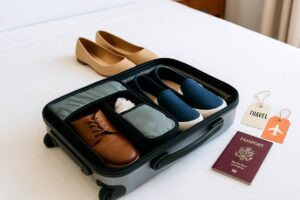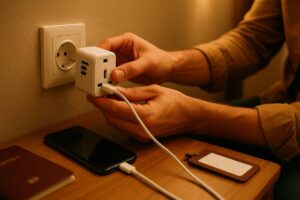Picture this: you’re sipping espresso in a bustling European café, Wi-Fi icon lit up, and… your next login credentials are already in the hands of cybercriminals.
In an age where 87.9% of websites default to HTTPS, the other 12.1% still expose travelers’ data to eavesdroppers.
Before you board, backup every photo and document (cloud use jumped from 28% to 54% in three years), patch your software, and encrypt your drives.
Lock down passwords with a trusted manager and plan to ditch unsecured hotspots for VPNs or your own mobile tether—because the only baggage you should lose is your jet lag, not your digital privacy.
Pre-Travel Preparations
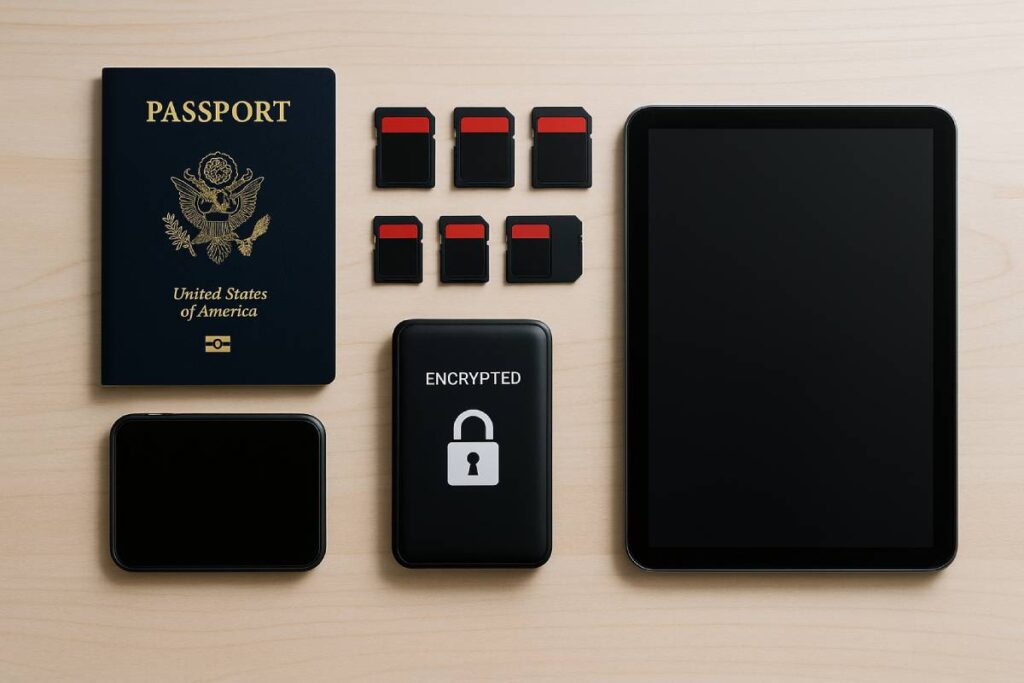
Before you set foot out the door, the cornerstone of any robust travel cybersecurity plan is thorough Pre-Travel Preparation: back up your irreplaceable photos, contacts, and documents both locally and in the cloud; sanitize devices by removing unneeded sensitive data; apply every available OS and app security patch; turn on full-disk encryption; and lock down your online accounts with unique passphrases, a trusted password manager, and even disposable “burner” accounts when warranted.
Data Backup & Device Sanitization
Backing up your photos, contacts, and documents both locally and in the cloud ensures you can restore essential data if devices are lost or stolen. Using portable drives—such as SSDs with built-in SD-card slots—lets you carry a self-contained backup that works offline and syncs automatically when you return. As a final safeguard, remove any non-essential or sensitive files—bank statements, proprietary research, and personal records—from your devices to minimize risk if they fall into the wrong hands.
| Backup Method | Pros | Cons |
|---|---|---|
| Local SSD/Hard Drive | Fast restore, no Internet needed | Risk of physical loss or damage |
| Cloud Storage | Off-site redundancy, accessible anywhere | Relies on connectivity; potential fees |
| Multi-SD Card | Inexpensive, simple plug-and-play | Small capacity; easily misplaced |
Software Updates & Encryption
Before departure, ensure your operating system and all installed apps are fully updated—these patches close known vulnerabilities that attackers often exploit. According to CISA, “keeping software up to date is one of the simplest and most effective defenses against remote attacks”. Next, enable full-disk encryption on laptops and mobile devices to protect data at rest; most modern platforms support this natively, with Windows using BitLocker, macOS FileVault, Android’s device encryption, and iOS’s integrated hardware-level encryption. If a device is confiscated, lost, or stolen, encryption prevents unauthorized reading of your files.
| Platform | Encryption Tool | Notes |
|---|---|---|
| Windows 10/11 | BitLocker | Built-in, requires Pro edition or higher |
| macOS | FileVault | Enabled in Security & Privacy preferences |
| Android | Device encryption | Often on by default; check Settings |
| iOS | Hardware encryption | Always on when passcode is set |
Account & Password Management
Unique, complex passwords—or better yet, long passphrases—are essential to thwart brute-force and credential-stuffing attacks. Adopt a reputable password manager such as 1Password or Bitwarden to generate, store, and sync secure credentials across devices without needing to memorize them. For the highest-risk trips—visiting countries with elevated surveillance or traveling with proprietary data—consider using burner accounts (temporary email or social profiles) that contain no personal information; if compromised, your primary identity stays intact.
By methodically executing these pre-travel steps, you dramatically reduce the chances that device loss, theft, or cyberattacks will derail your journey or expose your private data.
Secure Connectivity on the Go
Public Wi-Fi and charging stations pose real risks when you’re on the move: hackers can intercept your data via man-in-the-middle eavesdropping using rogue “evil twin” hotspots, and juice-jacking attacks at public USB charging ports can install malware or steal files.
The safest alternative is a trusted VPN or your phone’s mobile hotspot—mobile data connections are inherently more secure than open Wi-Fi and let you handle sensitive tasks without fear of snooping. Before connecting, always verify the network’s SSID with venue staff and steer clear of look-alike access points designed for phishing.
Risks of Public Wi-Fi
Man-in-the-Middle & Eavesdropping
Public Wi-Fi hotspots often lack encryption, allowing attackers to intercept unencrypted traffic between your device and the server—known as a man-in-the-middle (MITM) attack. By setting up an “evil twin” network that mimics a legitimate SSID, hackers can capture your login credentials, financial data, and personal messages without your knowledge.
Juice-Jacking at Public Charging Stations
When you plug into a public USB port—whether at an airport kiosk or café—a compromised charger can install malware on your device or exfiltrate data over the same cable used for power. Although no widespread real-world cases have been documented beyond proof-of-concept, the theoretical risk remains, and a simple data-blocker (USB “condom”) or carrying your own charger eliminates this threat.
VPNs & Personal Hotspots
VPN Service Comparison
Choosing the right VPN means balancing speed, security features, and global coverage. The table below compares four top providers:
| VPN Service | Key Features | Pricing (Monthly) | Annual/Biennial Pricing | Server Locations |
|---|---|---|---|---|
| ExpressVPN | AES-256 encryption, Lightway protocol, TrustedServer RAM servers, kill switch, 24/7 support | $12.95 | $6.67/mo (1-year), $4.99/mo (2-year) | 105 countries |
| NordVPN | AES-256, NordLynx protocol, Threat Protection, no-logs, 10 devices | $12.99 | $4.99/mo (1-year), $3.39/mo (2-year) | 118 countries; 7,300 servers |
| Proton VPN | AES-256, Secure Core double-hop, audited no-logs, P2P support | $9.99 | $3.99/mo (1-year), $3.59/mo (2-year) | 117 countries; 12,198 servers |
| Surfshark | AES-256, WireGuard, CleanWeb ad/malware blocker, unlimited devices | $2.19 | $1.99/mo (2-year; 3 free months) | 100 countries |
Mobile Hotspot vs. Free Wi-Fi
Mobile data connections are secured by your carrier’s network encryption and authentication layers, making them far safer than unencrypted public Wi-Fi. If you need to use a laptop or tablet, enabling your smartphone’s personal hotspot adds a password-protected layer between you and potential eavesdroppers, eliminating risks like MITM and juice-jacking on Wi-Fi networks.
Verifying Network Authenticity
Check SSID Legitimacy
Always confirm the exact SSID (network name) with staff or signage before connecting. Legitimate venues will provide the correct network name and any required passwords—avoid networks whose names differ by even a single character, as these may be “evil twin” traps.
Avoid Phishing-Style Access Points
Be wary of captive portals that ask for excessive personal details beyond a simple acceptance of terms and conditions. If a hotspot requires you to enter your email and create an account, verify its legitimacy independently or bypass it using your hotspot or VPN instead.
By understanding these on-the-go security practices—recognizing Wi-Fi threats, choosing the right VPN or hotspot, and verifying network authenticity—you’ll keep your data safe no matter where your travels take you.
Device Protection Strategies
Before you hit the road, think of your devices like suitcases: they need strong locks, a safe home base, and guarded charging stations. Use PINs or passcodes instead of easy-to-compel biometrics at border crossings; enforce instant or very short auto-lock timeouts; tether laptops and hide phones in portable safes or use Bluetooth trackers to keep tabs on valuables; and never trust unfamiliar USB ports—carry your own power bank and a “USB condom” data blocker for truly power-only charging.
Strong Device Locks
Use PINs/passcodes over biometrics at borders. Border agents worldwide can legally compel you to unlock devices with fingerprint or facial recognition—switch off those features and rely on a PIN or strong alphanumeric passcode instead.
Auto-lock settings and timeouts. A device left unlocked for even a minute can expose data to opportunistic thieves. Set your screen to sleep after 30 seconds and require a passcode immediately or within one minute of sleep return:
| Setting | Recommended Value | Benefit |
|---|---|---|
| Screen timeout | 30 seconds | Reduces window for on-screen snooping |
| Auto-lock delay | Immediately or 1 min | Ensures device locks quickly if left unattended |
Physical Security & Tracking
Security cables & Kensington slots. Anchor laptops and tablets to fixed furniture with a cable lock—look for devices compatible with the industry-standard Kensington Security Slot for maximum deterrence.
Travel safes & biometric locks. Keep phones, small cameras, and wallets in a portable biometric safe like the Trova Go Plus, which uses fingerprint or PIN access to protect valuables in hostel lockers or hotel rooms.
Bluetooth trackers. Slip a compact tag (e.g. Knog Scout or Apple AirTag) into your camera bag or strap it to your charger kit—real-time tracking via your smartphone helps you recover misplaced items quickly.
Keep devices in sight or locked. Whenever possible, carry your gadgets in an anti-theft bag; if you must leave them behind, secure them in the in-room safe provided (most hotels recommend using these for cash, passports, and electronics).
| Tool | Example Product | Key Features |
|---|---|---|
| Cable lock | Kensington portable lock | Fits K-Slot, steel braided cable |
| Travel safe | Trova Go Plus | Biometric unlock, aluminum shell |
| Bluetooth tracker | Knog Scout, Apple AirTag | 200 ft range, motion alerts, “Find My” network access |
Safe USB & Charging Practices
Avoid free USB ports; carry a power bank. Public USB outlets can secretly transmit malware or siphon data (“juice-jacking”). Always bring your own AC charger or a high-capacity power bank and cable.
Use a “USB condom” data blocker. For moments when you must plug into unknown ports—such as onboard a train—insert a USB data blocker (aka USB condom) between cable ends to physically disconnect data lines, allowing only power to flow.
By layering these strategies—robust passcodes, immediate auto-locking, physical tethers or safes, location trackers, and guarded charging options—you’ll significantly reduce the window of opportunity for both digital and physical theft, letting you focus on the adventure rather than worrying about your gear.
Safe Data Access & Usage
In today’s hyper-connected world, keeping your data safe means more than good passwords and antivirus software—you need proactive habits every time you go online. Always insist on encrypted connections (HTTPS), choose browsers that respect your privacy, and clear your digital footprints to prevent session hijacking.
Stay vigilant against phishing by scrutinizing sender details and arming your phone with trusted security apps. Finally, lock down your accounts with multi-factor authentication (2FA) and securely stash those precious backup codes. Below, you’ll find expert tips and practical steps—backed by the latest statistics and real-world advice—to keep your personal information under lock and key while you explore the globe.
Browser Hygiene
Always Use HTTPS
- Why it matters: HTTPS encrypts the data exchanged between your device and websites, preventing eavesdroppers from reading sensitive information in transit.
- Global adoption: As of mid-2025, 87.9 % of all websites default to HTTPS—up from 22.5 % five years ago—yet the remaining 12.1 % still expose you to man-in-the-middle attacks.
Consider Privacy-Focused Browsers
Not all browsers are created equal when it comes to data collection. Recent tests reveal significant differences in how much user data each browser harvests:
| Browser | Data Collected | Privacy Highlights |
|---|---|---|
| Google Chrome | 20 types (contacts, financial) | Fast, but heavy on telemetry |
| Microsoft Edge | 15 types | Integrates with Microsoft services |
| Firefox | Moderate | Open-source, strong tracker blocking |
| Brave | Identifiers & usage only | Built-in ad/tracker blocker, easy HTTPS upgrade |
| Tor Browser | None | Routes traffic through encrypted relays for maximum anonymity |
Clear Cookies & History After Sessions
Cookies store your login status and preferences—but they can also be stolen to hijack sessions. Deleting cookies, cache, and browsing history at the end of each session dramatically reduces this risk. In practice, enabling “clear on exit” in your browser settings ensures you leave no trace on shared or public devices.
Phishing & Malware Prevention
Spotting Fake Emails and SMS
- Volume of attacks: In 2025, phishing remains the top vector for cybercrime, with 3.4 billion phishing emails sent daily and 57 % of organizations facing weekly or daily phishing attempts.
- Red-flag indicators: Always hover over the sender’s address to confirm the domain (e.g., “@yourbank.com” vs. “@yourbank.securelogin.com”). Greetings like “Dear customer” can signal bulk phishing.
- Best practice: Never click links or download attachments from unexpected messages; instead, visit the official website directly or contact the organization through known channels.
Installing Mobile Security Apps
Your smartphone can be a frontline defense against malware and theft. Here are top-rated safety apps for travelers:
| App Name | Key Features | Platform |
|---|---|---|
| Emergency App | Alerts for 14 disaster types, customizable notifications (Red Cross) | iOS, Android |
| Travel Smart App | Real-time safety updates, geo-alerts, offline mode | iOS, Android |
| Lookout Mobile | Malware scanning, theft alerts, Wi-Fi security tests | iOS, Android |
Installing at least one of these ensures you receive timely warnings about local threats, suspicious networks, and lost-device recovery tools.
Two-Factor & Biometric Authentication
Setting Up 2FA for Key Accounts
Adding a second verification step—whether via an app, SMS code, or hardware token—cuts the risk of account compromise dramatically. Yet as of early 2025, only 39 % of organizations had implemented MFA, leaving many users vulnerable. Prioritize enabling 2FA on your email, banking, and cloud-storage accounts to stay one step ahead of attackers.
Backup Codes & Alternate Devices
- Secure storage: Treat your 2FA recovery codes like cash—store printed copies in a safe deposit box or encrypted vault (e.g., VeraCrypt).
- Use alternate tokens: Where possible, use a hardware key (YubiKey) or an authenticator app (Authy, Google Authenticator) instead of SMS to avoid SIM-swap scams.
By integrating these Safe Data Access & Usage strategies—rigorous browser hygiene, vigilant phishing defenses, and robust multi-factor authentication—you’ll fortify your digital perimeter and travel with confidence, knowing your personal information is shielded no matter where airline lounges or hotel Wi-Fi networks take you.
Border & Customs Considerations
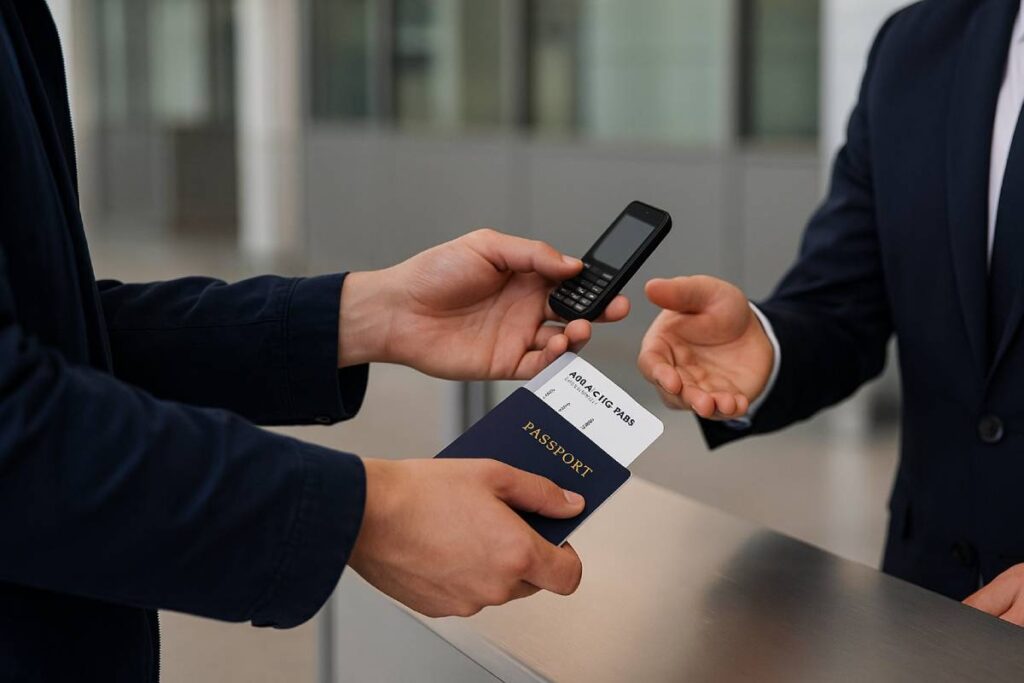
Before you reach the immigration line, know that electronic device searches at borders are not just theoretical—they’re happening more often, and with broad authority. In Fiscal Year 2023, U.S. Customs and Border Protection (CBP) conducted 41,767 warrantless searches of travelers’ phones, laptops, cameras, and storage media at ports of entry.
While U.S. citizens cannot be denied entry if they refuse to unlock devices, they may face detention or confiscation; non-citizens risk visa denial or extended questioning. To stay in control of your digital life abroad, strip devices down to essentials or carry a “burner” phone loaded only with travel-critical apps. Finally, leave sensitive files at home and rely on encrypted cloud storage—so you can access what you need without packing it in your carry-on.
Understanding Legal Device Searches
Rights and Obligations at U.S. and International Checkpoints
All travelers entering the United States are subject to CBP’s broad search authority, which allows officers to examine electronic devices without a warrant or suspicion. In Fiscal Year 2023 alone, 41,767 devices were searched—double-checking emails, social media, photos, and documents for customs or security violations. U.S. citizens retain a guaranteed right to enter, even if they refuse to provide passcodes, but may face temporary detention, device seizure, or advanced forensic inspection.
By contrast, non-citizens and permanent residents who refuse can be denied entry, have visas revoked, or undergo prolonged interrogation. Civil liberties groups like the ACLU argue that such sweeping authority undermines Fourth Amendment protections and have urged courts to require probable-cause warrants.
Minimizing Data Footprint: Use of Burner Devices
Seasoned travelers recommend a “clean” or burner device approach to comply with border inspections while safeguarding your primary data. Strip your phone or tablet of personal emails, photos, and work documents—install only essential travel apps (maps, translation, authentication). For maximum peace of mind, carry an inexpensive smartphone that’s unlinked to your main identity; if seized, you lose little beyond basic travel tools. NGOs like the Electronic Frontier Foundation contend that this strategy helps you uphold your privacy rights without running afoul of border agents.
Minimizing Carried Data
Leaving Sensitive Files Behind; Using Encrypted Cloud Storage
Prior to departure, remove all non-travel-critical files—bank statements, personal photos, proprietary work documents—from your devices. Store only what you absolutely need for the trip. Instead, upload sensitive materials to a Zero-Knowledge encrypted cloud service (e.g., Dropbox with client-side encryption), ensuring that files remain unreadable without your private keys. This approach reduces what border agents can physically inspect, while still allowing you to retrieve documents on demand. Always perform a test restore before you travel to confirm that you can access your data under different network conditions.
| Strategy | Benefit | Example Tools |
|---|---|---|
| Burner Devices | Limits exposure of personal data | Cheap Android/iPhone, minimal app install |
| Encrypted Cloud Storage | Removes files from device; access anywhere | Dropbox (client-side), NordLocker |
| Pre-Travel Data Purge | Ensures nothing excess remains on device | Manual deletion, factory reset where needed |
| Test Restore Workflow | Verifies access continuity abroad | Cloud backup restore checks |
By understanding and preparing for device searches—knowing your rights, minimizing what you carry, and leveraging burner devices and encrypted cloud storage—you’ll cross borders with confidence, keeping your personal and professional data under lock and key no matter where your journey takes you.
Incident Response & Recovery
Below is a concise overview of best practices when disaster strikes on the road: immediately lock or erase your device with “Find My…” services on both iOS and Android; change all critical account passwords to block unauthorized access; swiftly notify banks, embassies, and insurers and file a police report to kick off any necessary claims; and finally, restore data from your backups—verifying its integrity before relying on it—to get back online safely and resume your travels.
Lost/Stolen Device Protocol
1. Remote Lock & Wipe
Use device-tracking services to secure or erase your gear at the first sign of trouble:
- iOS (“Find My”): Enable Managed Lost Mode to lock your iPhone, display a custom message, track its location, or remotely erase all data .
- Android (Find My Device): From your Google Account, locate, lock, or factory-reset any missing Android phone or Wear OS watch.
| Platform | Service | Actions Supported |
|---|---|---|
| iOS | Find My (Lost Mode) | Lock, display message, track, erase data |
| Android | Find My Device | Locate, ring, lock, erase device |
2. Change Critical Passwords
Immediately update passwords for your most sensitive accounts—email, banking, and cloud storage—to cut off any session tokens or saved credentials on the lost device. Use a secure password manager to generate new, complex credentials and revoke any active device sessions in your account settings.
Reporting & Support
1. Contact Banks, Embassies & Insurers
- Banks & Credit Cards: Call the global customer-service numbers printed on the back of your cards (or via online banking) to freeze or cancel accounts and request replacement cards.
- Embassy/Consulate: Report stolen passports or IDs; they can issue emergency travel documents and advise on local procedures.
- Travel Insurance: Notify your insurer within 24–48 hours—policies often require filing claims shortly after an incident to cover device replacement or related expenses.
| Entity | Contact Method | What to Provide |
|---|---|---|
| Bank/Credit Card | Phone/Online Portal | Account number, date and location of loss/theft |
| Embassy/Consulate | Phone/Email/In Person | Passport number, police report copy |
| Insurer | Phone/Email | Policy number, proof of ownership, police report |
2. Filing Police Reports
Obtain a formal police report from local authorities—this document is crucial for both insurance claims and potential identity-theft remediation. Request multiple certified copies, as insurers and consulates often require originals.
Restoring Data
1. Safe Backup Restoration
Once you have a replacement device, restore from your previously created backups:
- iOS: Use Finder (macOS 10.15+) or iCloud to restore your iPhone, following Apple’s step-by-step guide.
- Android: Sync your Google account, then reinstall apps and restore settings from your Google One or device backup.
2. Data Integrity Verification
Before resuming normal use, verify that restored files are complete and uncorrupted by comparing checksums or file counts against your backup logs. Automated backup tools or manual checksum scripts ensure that no data was lost in transit.
| Backup Method | Restoration Tool | Integrity Check |
|---|---|---|
| Local Disk/SSD | Finder, Windows Explorer | Compare file sizes and counts |
| Cloud (iCloud/Drive) | Native restore wizard | Recalculate checksums for key files |
| Encrypted Vault | VeraCrypt/OpenSSL | Verify with stored hash lists |
By following this Incident Response & Recovery roadmap—locking and wiping lost devices, changing passwords, reporting to key institutions, and carefully restoring your data—you’ll mitigate damage, expedite any claims, and get back to your travels with minimal disruption.
Tools & Solutions Comparison
In today’s fast-paced travel environment, choosing the right digital-security tools can mean the difference between a worry-free journey and a compromised itinerary. Leading VPN providers such as ExpressVPN offer servers across 105 countries with AES-256 encryption for consistent speed and privacy, while NordVPN boasts 7,733 ultra-fast servers in 118 countries and a strict no-logs policy.
Surfshark delivers a robust network of over 3,200 RAM-only servers in 100 countries, optimized for streaming at 10 Gbps speeds, and ProtonVPN has rapidly expanded to more than 11,000 servers in 110+ countries, including Secure Core double-hop and audited no-logs architecture.
On the password-management front, 1Password and LastPass both enforce end-to-end, zero-knowledge encryption to keep credentials safe on every device, whereas Bitwarden’s open-source platform supports unlimited devices on its free plan and Dashlane adds a built-in security dashboard plus AES-256 protection.
Finally, physical travel-security kits range from Kensington cable locks with standard K-Slot compatibility for laptops, to Tile Pro Bluetooth trackers offering up to 400 ft of range for locating valuables, and portable power banks (up to 27,000 mAh) certified safe for cabin carry under international airline rules.
| Tool Category | Option A | Option B | Key Features |
|---|---|---|---|
| VPN Services | ExpressVPN<br/>NordVPN | Surfshark<br/>ProtonVPN | Server count, AES-256 encryption, jurisdiction<br/>Speed protocols (WireGuard, Lightway) |
| Password Managers | 1Password<br/>LastPass | Bitwarden<br/>Dashlane | End-to-end zero-knowledge encryption<br/>Multi-device syncing<br/>Security dashboards |
| Travel Security Kits | Kensington cable lock<br/>Tile Pro tracker | High-capacity power bank<br/>USB data blocker | Physical K-Slot security<br/>Bluetooth tracking (400 ft)<br/>Portable charging (up to 27,000 mAh)<br/>Data-only charging adapter |
Category Highlights
- VPN Services: ExpressVPN’s global fleet (105 countries) leverages AES-256 and its proprietary Lightway protocol for sub-20 ms latency in major hubs. NordVPN’s 7,733 servers across 118 countries focus on NordLynx for speed and Threat Protection to block malware. Surfshark and ProtonVPN deliver comparable coverage—3,200+ and 11,000+ servers respectively—while each adds unique privacy features like RAM-only servers and double-hop routing.
- Password Managers: 1Password enforces AES-GCM-256 end-to-end encryption, making data unreadable in transit or at rest. LastPass uses zero-knowledge local encryption before cloud syncs, ensuring only devices hold decryption keys. Bitwarden’s open-source model supports unlimited credentials across devices even on its free tier, and Dashlane layers AES-256 encryption with a security dashboard for breach monitoring.
- Travel Security Kits: Kensington’s K-Slot cable locks anchor laptops to immovable fixtures and deter opportunistic theft. Tile Pro trackers boast up to 400 ft Bluetooth range, loud ring, and integration with Apple’s Find My and Amazon Sidewalk networks. Airline-approved power banks (≤27,000 mAh) from reputable brands comply with cabin regulations to keep your devices charged safely, and USB data blockers (“USB condoms”) physically block data pins for purely power-only charging scenarios.
By matching these tools to your travel needs—whether securing your internet traffic, safeguarding credentials, or physically protecting your gear—you’ll strike the right balance of convenience, performance, and peace of mind on every trip.
Conclusion
Travelers today face a dual threat: pickpockets on the street and data thieves online. By embedding these digital-security steps into your travel routine—backing up and sanitizing devices, applying every OS patch, enforcing full-disk encryption, and adopting a password manager—you close the door on the most common pre-trip vulnerabilities.
On the road, swap risky public Wi-Fi for VPN-protected or personal hotspots, verify SSIDs with staff, and deploy short auto-lock delays and physical security measures like cable locks and safes to safeguard your gear. Adopt rigorous browsing hygiene—HTTPS only, cookie clear-outs, and 2FA on all critical accounts—to avoid phishing traps and session hijacking.
Know that CBP can perform border device searches without a warrant—carry only travel-essential data on burner phones and leverage encrypted cloud storage for the rest. And if the worst does happen, immediately remote-wipe your device, lock down or rotate credentials, and engage banks, embassies, and insurers to file claims. Final recovery is straightforward—restore verified backups and resume your journey with confidence that your digital life is as secure as your passport.
FAQs
1. What if I must use public Wi-Fi abroad?
Always connect through a reputable VPN or your phone’s hotspot, never access banking/email directly, and verify SSID legitimacy with staff.
2. Can border agents force me to unlock my phone?
Yes—while you can refuse, CBP’s warrantless search authority may lead to temporary detention or device seizure. Use a PIN, not biometrics, and carry a burner device with minimal data.
3. How do I safely restore data after a loss?
Use “Find My…” to lock or wipe, then restore from iCloud or encrypted local backups. Verify file counts/checksums before daily use.
4. What’s the best way to avoid phishing while traveling?
Never click unknown links or attachments; verify sender domains; install a mobile security app with phishing detection.



